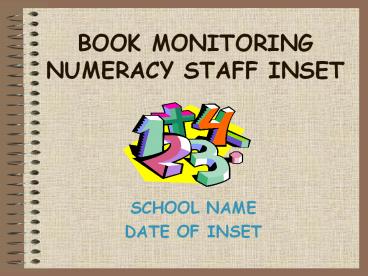BOOK MONITORING NUMERACY STAFF INSET - PowerPoint PPT Presentation
1 / 18
Title:
BOOK MONITORING NUMERACY STAFF INSET
Description:
BOOK MONITORING NUMERACY STAFF INSET SCHOOL NAME DATE OF INSET Objectives of INSET To feedback findings from monitoring of children s books. To discuss ways to ... – PowerPoint PPT presentation
Number of Views:118
Avg rating:3.0/5.0
Title: BOOK MONITORING NUMERACY STAFF INSET
1
BOOK MONITORINGNUMERACY STAFF INSET
- SCHOOL NAME
- DATE OF INSET
2
Objectives of INSET
- To feedback findings from monitoring of
childrens books. - To discuss ways to continue current good
practice. - To highlight, discuss and prioritise points for
action. - To consider next steps and focus of future
support.
3
Questions to consider...
- Why do we monitor childrens work?
- Who should be
- responsible for
- monitoring work?
- What are the next steps for monitoring
- within school?
4
Monitoring Cycle
Training Shared focus Shared expectations
Monitoring Plans Childrens work Lessons
Evaluation Good Practice Areas for development
5
The process of monitoring
- Monitoring grid and guidelines
- Medium and short term planning
- Lesson observations
- Interviews with children
- Highlighting implications for learning and
teaching
6
Areas of good practice
7
Presentation
- Is there a whole school policy for presentation?
- Setting out calculations
- 1 digit per square
- Dates and titles
- Clearly labelled front covers
- Colouring in
- Pens and pencils
8
Recording work
- How and where are jottings recorded - empty
number lines, working out? - What type of books and paper do we use to record
on? - Do we need to review the types of books and paper
we use? - Where should worksheets and assessments be filed?
- Is the published scheme cost effective?
9
Marking
- Does the type of marking in the books reflect our
marking policy? - How do we show who is marking the work?
- Marking related to learning objectives?
- Using a marking key?
- Written comments praise, evaluative and
targets? - How and when should children start marking own
work?
10
Accuracy
- How should ?
- children correct mistakes?
- wrong answers be marked?
- teachers track work and corrections?
- What should happen if there is consistently
incorrect answers/misconceptions?
11
Range and balance of work
- Whole school approach to use of Unit Plans
- Noting on short term planning if an activity is
practical or resource used - How do you know that you have covered all the
learning objectives? - Use of traffic light system
12
Range and balance of work
- Is a record keeping system used to track
attainment and progress? - Progression of topics and concepts
- Calculator skills
- Using and applying maths
- ICT
- Use of supplements of examples when planning and
teaching.
13
Differentiation
- Are you catering for all ability groups of
children in your class? - How do you show differentiation in planning?
- Consider differentiation by outcome, support, use
of resources and type of activity. - Note activities for higher, average and lower
attainers and role of adults on short term
planning - Development of guided group work.
14
Open ended tasks
- Do you plan and teach a variety of
- tasks that are open ended?
- Consider a range of investigations, different way
of approaching tasks and varied questions. - Mathematical challenges for more able pupils in
Key Stages 1 and 2 - DfEE 0083/2000 Tel 0845 60 222 60
15
Spaceship
- Some Tripods and Bipods flew from planet Zeno.
- There were at least two of each of them.
- Tripods have 3 legs.
- Bipods have 2 legs.
- There were 23 legs altogether.
- How many Tripods were there?
- How many Bipods?
- Find two different answers.
16
Mental to written calculations
- The development of recording mental strategies in
KS1. - Is there sufficient evidence of jottings,
expanded and compact methods of calculation in
the books? - Has a whole school approach to expanded and
compact methods for the four operations been
decided upon?
17
Teacher absence
- Are supply teachers aware of the NNS framework,
schools marking policy and approach to numeracy
and calculations? - How do we monitor supply teachers work?
18
Next steps
- Discuss issues as a staff
- Decide upon a whole school approach
- Highlight any additional training or support that
is needed - Individual classes, year groups and whole school
monitoring































